Course:FNH200/2011w Team06 RedWine
Introduction to Red Wine Making Kits and Red Wine Processing

Wine-making is the process of fermenting the juice of grapes to create an alcoholic beverage. This process was originally noted in Mesopotamia and Caucasia around 8000 years ago.[1] Since then, the process has evolved considerably and new technology continues to revolutionize the wine industry. With new technology, shortcuts and other marketing strategies have been developed in order to appeal to consumers. An example of this is kit wine. Kit wines are a ready-made concentrate which consumers can use to ferment their own wine. This is cost effective for the consumer, but will the kit wine have the same quality as commercially made wines? Both commercial and kit wines are derived from grapes, and the growing site of these grapes plays an important role in determining a wine’s character. Grapes for kit wine are often of low quality to begin with.[1] Other flavour determining factors include weather, lighting conditions, and temperature. These contribute a distinguishable taste to wine so that the same grapes result in different wines in different regions.[1] With many factors affecting the quality of the wine and increasing options for processing techniques, wines that achieve an optimal combination of these factors are of the highest quality. Does the use of a concentration decrease the quality of the wine? How do the fining processes differ between commercial and kit wines? Does the lack of pressing in kit wine affect its quality? The next sections discuss exactly how the different processes affect the wine.
Harvesting and Crushing
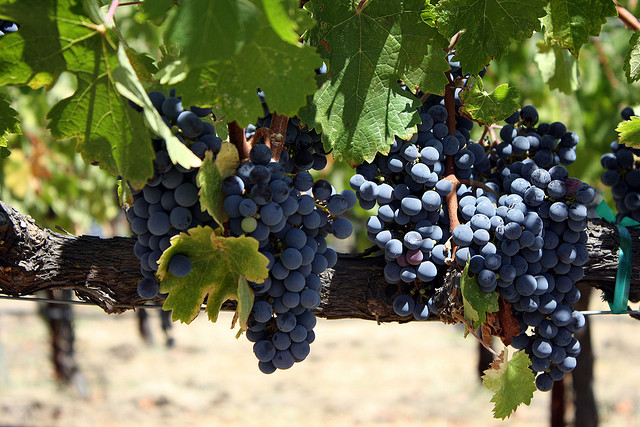
Undoubtedly, the harvesting of grapes is the essence of creating wine. This initial step is vital in wine production as grapes are the only fruit which can produce enough sugar to yield an appreciable amount of alcohol to preserve the beverage. No other fruit contains the specific tannins and acids necessary to produce the consistency of wine.[2] As previously mentioned, different factors such as climate, soils, and the vine itself are all major contributors in the harvesting of fine wine.
A climate best suited to harvest a crop of grapes is one with excellent sun exposure, minimal frigid temperatures, and adequate soil drainage.[3] In these areas, the risk of frost is lessened- therefore allowing the production of grapes to thrive. Higher elevations are also more apt for growing grapes as they promote better air drainage throughout the growing season and reduce the growth of disease-related organisms. The final key component in grape production is the length of the growing season. This is determined by the first and last frosts of the year. In cooler regions, the average growing season is between 150-160 days, whereas warmer climates receive 200 or more days of harvesting.[3]
The beauty of grapevines is that they can easily adjust to a wide range of soil types; however they function best under very developed root systems. Superior soil conditions favorable to root growth include loose texture, moderate fertility, and sufficient aeration. In extremely wet conditions, root growth diminishes due to a lack of quality soil drainage. As a result, vine growth and crop yields are relatively low.[3]
Grapevines are classified as a higher form of plant due to their characteristic features: the leaves, stems, and roots. Some of the sugars produced via photosynthesis are used in the plant’s metabolic process, while another portion is stored in the grapevine’s roots, which proceeds to the transportation of roots to berries.[3] This transfer is the very reason a high level of sweetness arises from the fruit. Generally, grape quality is associated with the fruit’s sweetness level. Grape growers closely monitor the sweetness levels in order to receive the fullest amount of sugar content from the fruit.[3]
Harvesting can be conducted mechanically or by hand. Most harvesters prefer the latter option as this method is less abrasive. Once harvested, the grapes are sent to be sorted before crushing can begin. Diminished, rotten, or under-ripe grapes will be eliminated from the next step.
Crushing of the grapes is conducted in order to promote berry breakage and the release of juice contents. This step forces the juice, skin, pulp, and seeds to interact with one another, determining the amount of extraction from these components.[2] The removal of stems from the juice and skins also occurs during this process. Stems are extracted from the juice, shredded, and disposed as solid waste material. Field crushing is a popular trend amongst harvesters as this process directly disposes stems into the vineyard. One of the advantages includes an effective increase of antioxidants.[2] Stems are removed from the grapes before fermentation, due to the relatively high tannin content.
Concentration

Kit wines may be made of grape juice or grape concentrate which are available in cans or bladder packs to preserve the concentrate and extend its shelf life.[4] The grape concentrate has a thick, viscous consistency due to the high amount of grape sugar. This consistency also determines the type of wine that the concentrate will yield. These concentrates lack the presence of skins and seeds, which play an important role in flavour development.[4] Low quality grapes lead to little character or flavour in the wine; therefore, it is important to obtain the best quality concentrate to make a characterful wine.[4]However, many kit wines use lower quality grapes. The concentrate is stored at low-temperature, in a partial-vacuum environment. Since the use of low quality grapes is common, sugar or artificial colours may be added.[4]This process is unnecessary for commercial wines, which keep the grape juice in contact with the seeds and skins throughout fermentation to develop the flavour.
Chaptalization and Acidification
For commercial red wine, the grape juice is gathered in stainless steel settling tanks to cool down. These tanks may be covered with CO2 or N2 in order to reduce oxidation.[5] In addition, glucosidases may be added to enhance the fruity aromas of the juice[5]. Debris must be suspended in the juice in order to prevent loss of fruitiness during fermentation[5]. This is achieved by a clarifying agent such as silicon dioxide.[5] Then, the must is left for about 24 hours to settle and is racked off[5]. If the juice contains less sugar than is required to reach a target Alcohol by Volume (ABV) level in the final product, the juice may undergo chaptalization by adding sugar to raise ABV.[5] If the juice is too low in acidity, then tartaric acids may be added for acidification.[5] On the other hand, over-acidic juice may be ameliorated, by diluting the juice with sugar water.[5] However, it is important to keep in mind there are specific regulations for commercial winemaking and depending on the region, these processes may be allowed to some degree or may be illegal.[5]
Similar to the commercial wine, kit winemakers also add tartaric acid to acidify the must that is deficient in acidity.[6] When there are excessive levels of acidity in the must, winemakers may use calcium carbonate (CaCO3) or potassium carbonate (K2CO3) to ameliorate the acidity.[6] However, adding sugar to immature fruit is not advised, unless the winemakers intend to drastically increase the ABV.[6]
Fermentation

Fermentation is essential in importing the unique flavour and microbiological stability to red wine.[7] In commercial red wine, the must (freshly crushed grapes including the skin and seeds) will first undergo alcoholic fermentation, which converts the glucose and fructose of the grapes into ethanol by inoculating the must with yeast.[6][8] The following illustrates the chemical reaction that takes place during alcoholic fermentation.
C6H12O6 → 2CH3CH2OH + 2CO2 + Heat[8]
An active, dry yeast starter culture of Saccharomyces cerevisiae is inoculated into the must in steel vessels or wooden oak barrels.[8][9] Since carbon dioxide is a by-product, an anti-foaming agent (silicone product) is added at the start of fermentation to reduce foaming.[6] This fermentation process takes place at 25-30°C for at least 5 days with light red wines (with less alcohol content) such as Pinot Noir and Sangiovese or for more than 2 weeks with full bodied red wines (with more alcohol content) such as Cabernet Sauvignon or Carménère.[10] The ethanol that is produced helps to extract colour, flavours and tannins from the must.[10] During the alcoholic fermentation of kit wine, the grape juice concentrate is warmed to 20-25°C in a sealable plastic bucket while S. cerevisiae starter culture and oak chips are added into the concentrate.[11] The concentrate is fermented at 25-30°C for the same amount of time as commercial red wine with light and full bodied red wine.[11]
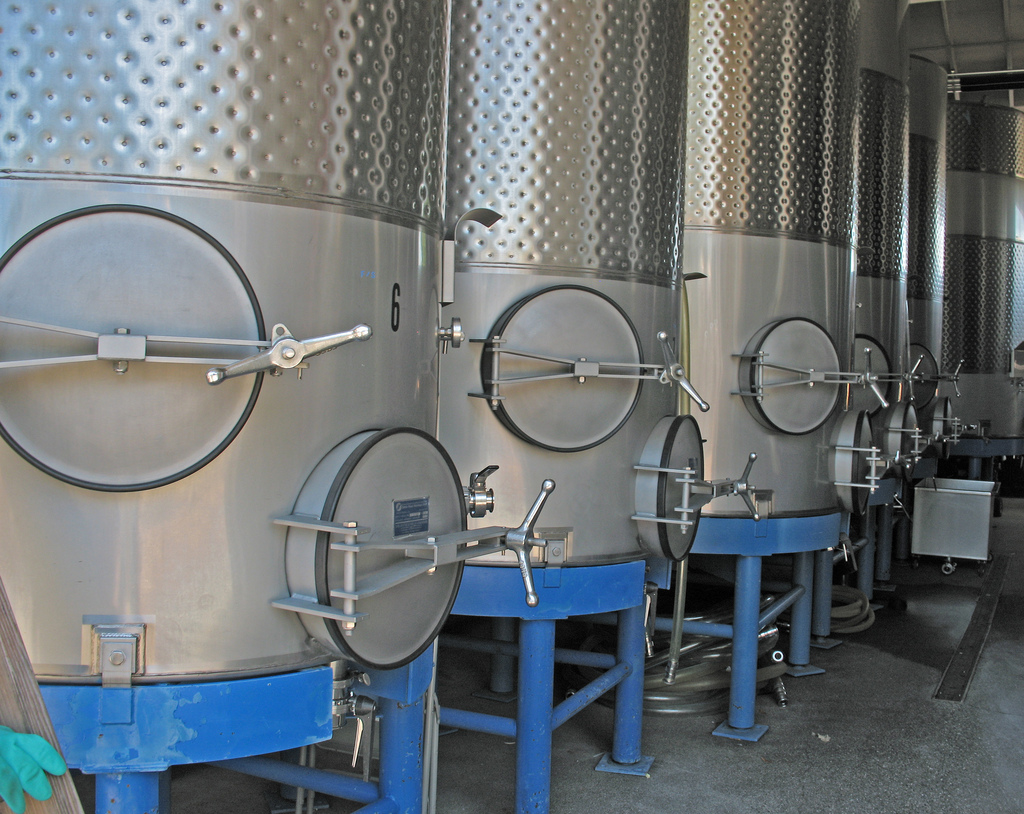
Once the alcoholic fermentation has finished, the must of commercial red wine will immediately undergo a second fermentation process called malolactic fermentation(MLF), which uses lactic acid bacteria for decarboxylation of malic acid in grapes to form lactic acid.[8][12] The following illustrates the chemical reaction that takes place during malolactic fermentation.
HOOCCH2C(CH)HCOOH → CH3CHCOOH + CO2[8]
A freeze-dried, gram-positive, lactic acid bacteria starter culture includes genera Lactobacillus, Leuconostoc, Pediococcus and Oenococcus. These facultative anaerobes are introduced into the must.[7] Strains of Oenococcus, resistant to certain bacteriophages can be selected and used in the starter culture as genetically modified bacteria.[7] MLF is a slower process, which takes about several months to complete at 20-30°C.[7] MLF conducted in oak barrels will produce a softer, richer and less astringent wine than that in steel vessels.[7]
Since the lactic acid that is produced is less acidic than malic acid, the wine pH can rise by 0.1-0.3 pH units to pH of 3.8.[12] The increase in pH can cause the anthocyanin in must to become less red in colour.[12] Unlike commercial red wine, red kit wine does not undergo MLF because the grape concentrate contains a high concentration of malic acid. If all the malic acid is converted into lactic acid, the acidity of the wine will drop and the pH will be beyond 3.8.[12] This type of environment facilitates bacterial spoilage.[12] Lactic acid bacteria can contribute to flavour in commercial red wine by producing flavour-active compounds such as diacetyl, which is an aromatic diketone that provides a buttery, nutty aroma.[7] The colour and aroma change is a good indication of microbiological stability.[13]
Pressing
Pressing is the process during which force is applied in order to isolate the juice from the grapes, skins and seeds. After primary fermentation, feet, plunger-type, vertical-screw or pneumatic presses can be used.[5] However, pneumatic presses are becoming more common.
Pneumatic Press
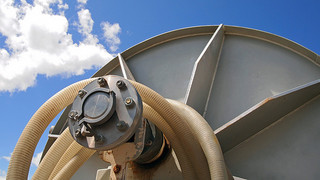
The must is pumped into the drum of a pneumatic (bladder) press. These are often cylindrical and crafted from stainless steel.[14] They generally contain a vinyl-like or synthetic membrane that acts as a bladder.[14] As the bladder is inflated with compressed air, it presses the grapes against a perforated surface on the other side of the drum which allows juice to drain.[15] As the pressure increases, the amount of tannin extracted from the skins increases.[15] When the desired amount of pressing is complete, a vacuum pump removes air from the bladder and decreases pressure in the drum.[15] This process can be automated (with various pressing options) or manual, when making commercial wines.[15]
These presses are used commercially to increase the quality of the must. The stainless steel walls of the drum can be filled with glycol in order to regulate temperature, and an airtight seal helps to prevent oxidation.[14] Some presses even have "a flow sensor [which] optimizes the pressing extraction time".[14] These presses are gentle enough to be used on many grape varietals and will not contaminate the juice with grease or metals.[15]
Unlike commercial wines which can sometimes even undergo a second pressing, kit wines are not pressed after fermentation since they are made from concentrates which no longer contain skins or seeds.[14] With the juice having less contact with the skins, kit wines will often lack the quality of commercial wines.[14]
Clarification and Stabilization
Clarification consists of racking, fining and filtration.
Racking
After the wine is cooled and settled from the primary fermentation, the liquid is racked slowly over the lees on the bottom of wine container.[5] In commercial winemaking, this is the stage when the winemaker decides what style is desired in the specific wine. For example, by delaying the racking of the liquid over the lees, the wine may adopt the style of sur lie, and develop bread dough flavors and a creamy mouth feel.[5] If the wine is racked into barrels, it may oxidize and develop a barrel bouquet of smoky woody and vanilla notes.[5] The racking of the large stainless steel wine tanks involves powerful electric transfer pumps and large hoses. [5] In kit winemaking, the winemakers rack the wine two or three times to both clarify and to remove any unwanted particles that may cause faults. The wine barrels are usually racked off the lees with plastic tubing and small pumps. [6]
Fining and Filtration
The major problems with commercial wine include excessive astringency, protein haze and more.[5] These problems are treated with the appropriate fining agents. There is generally less fining involved with red wine in order to maintain color pigments and texture.[5] Since, bentonite (clay) reduces the intensity of the red color in red wine, winemakers use egg white and gelatin.[5]
The fining agents that affect the taste of kit wine are more or less the same with commercial wine. However, the limited hygiene in winemaking conditions may allow the wines to become hazy and visually unattractive.[6] The clarity in color can be achieved by using sterile filtration equipments or maintaining 20 to 30 mg/l of free sulfur dioxide in wine as an antimicrobial agent.[6]
| Fining Agent | Problem |
|---|---|
| Gelatin | Tannins (astringent) |
| Egg albumen | Tannins (astringent) |
| Tannins | Proteins (haze) |
| Bentonite (clay) | Proteins (haze) |
| Casein | Acids & tannins |
| PVPP | Brown/ oxidized pigments |
Once the wine has endured the fining process and reaches an acceptable color and aroma/taste, it is said to fall brilliant.[5] Before both the commercial and kit wines are bottled, they are filtered to remove bacteria, yeast and other undesirable particles that may cause microbial faults and reduce wine clarity.[6] The filtration is done by either attracting and trapping unwanted particles or straining them through a membrane sheet to collect desirable particles and liquids.[6]
Stabilization
Unlike white wines which are especially susceptible to temperature, red wines are not chilled and naturally carry less tartrate crystals that facilitate haziness.[6] The tartrate crystals that do exist in red wines are mostly concentrated in the cork are. These are easily removed when the cork is pulled. While similar procedures can be applied to both commercial and kit wines, commercial wines tend to require a longer stabilization process due to the distance they travel to reach consumers.[6]
Maturation
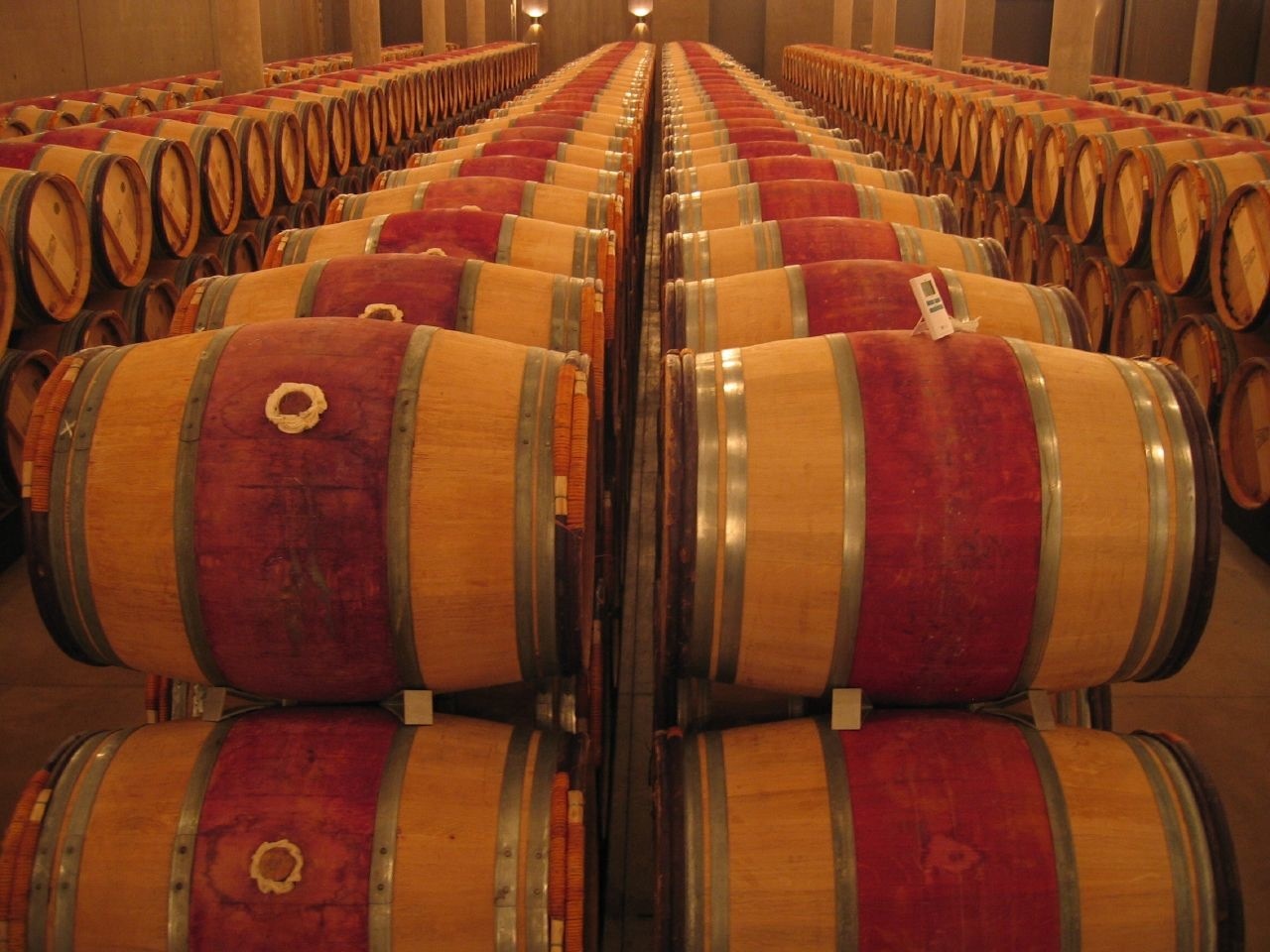
The colour of red wines range from extreme violet to bright red. Violet indicates, young wine and intense red indicates mature, older wine.[16] During commercial production, some wines may have tannin added which help to stabilize the colour of the drink and prevent it from rotting.[16] During the maturation and bottling processes, oxygen and light exposure is eliminated because it can affect the shelf life, and taste of the wine.[17] During maturation, wines are stored in dry, sanitized oak barrels for up to 15 months. Different types of wood may be selected for oak barrels to bring out certain flavours and tannin in the wine.[18] Moreover, through the aging process, the wine is either absorbed into the wood barrels or evaporated. To prevent any oxidation of wine, the barrels are topped off with more wine to eliminate any air pockets that may have been formed during maturation.[18] During this process, the wine undergoes malolactic fermentation which softens any acidity present in the wine and produces a smoother final product.[19] The wine is stored away from sunlight, in an oak barrel at a 11°C.[19] Some wine making companies may choose to filter the wine out of the barrels, bottle it and age it again.[19]
In kit wines, maturation takes place in the bottle.[6] The recommended time of aging is at least a month. Some wines, when made with good quality grapes, may be stored for up to four years without any development of foul taste or aroma.[6] It is suggested that bottle is stored on its side during maturation to keep the cork moist. This limits the formation of air bubbles which can contribute to spoilage in the product.[6]
Bottle

The Bordeaux style bottle is most commonly used, as it has more “shoulder” and larger “punt”. The “shoulder” and “punt” help to hold any sediment while pouring wine.
To begin the bottling process the bottles are sterilized using metabisulfite solution before filling with wine.[20]Once the bottles are cleaned, a bottle filler is used to fill the bottles until an inch of the top.[20]
Corking
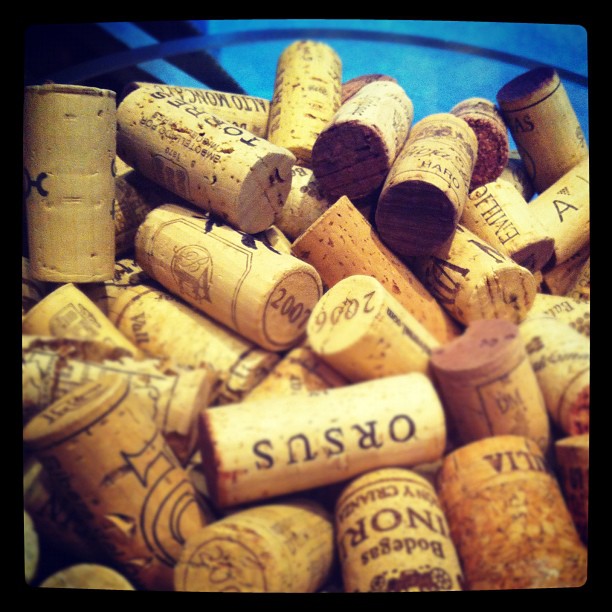
Cork is an ideal choice for sealing wine bottles because of its elasticity. Furthermore, it is easily compressed to fit accordingly into the neck of the bottle. Once the cork is inserted it will recover to its original size, sealing the bottle tightly. As for the capsule, a heat tunnel is used to shrink it around the neck of the bottle.[6]
There are two grades for corks:
1. The superior quality (dense compared to the lower quality), is used to seal high quality wine.[21]
2. The type of cork that is used to age the wine for more than five years.[21]
To begin the corking process, the cork is first softened; however, if steamed for too long it can become soft and spongy. This makes inserting the cork difficult.[21]It is then compressed. If overheated it can cause leaking during storage of the wine.[21] The cork is then inserted into the neck of the bottle, using a corking device (handheld/floor corker).[21] After corking, it is best to store the bottles standing up for a couple of days. This allows the cork to expand back to its original size.[21]
Labelling
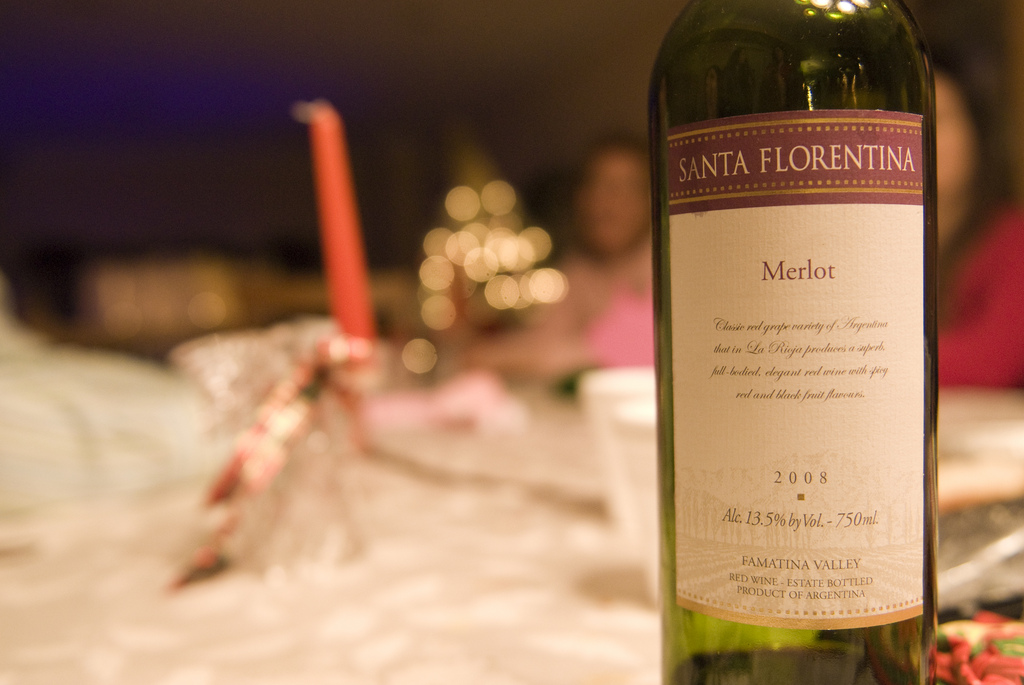
There are very strict regulations in regards to the labeling of commercial wines. Labels must include the name of producer and/or distributor, vintage (year grapes were harvested), grape varietal, alcohol percentage, volume of wine, any style/production techniques (oak-aged, aged in new barriques, barrel-fermented, oaked, unfined/unfiltered, organic, etc.).[10] A region is listed if wine is made within laws that specificy limits of area, vinegrowing, winemaking, techniques, and grape varieties. These are considered to be Quality Wines Produced in a Specified Region [QWPSR] and apply only for France, Italy, Spain, Portugal, Germany.[10]
Summary
The table below gives a brief summary which compares and contrasts the red wine making kits and the commercial red wine processing.
| Red Wine Making Kits | Commercial Red Wine Processing | |
|---|---|---|
| Harvest and Crushing | Same (However, grapes may be of lower quality.) | Same |
| Concentration | May have added color/sugar. | None |
| Chaptalization and Acidification | Same | Same |
| Fermentation | Only fermented once. | Has second phase of fermentation (MLF). |
| Pressing | None | Feet, Plunger-type, Vertical-screw or Pneumatic presses |
| Clarification and Stabilization | Similar (Lacking the same quality of hygiene, may cause impurities.) | Similar |
| Maturation | Takes place in bottle. | Takes place in wooden barrels, and after bottling. |
| Bottle | Unregulated | Strict label regulations. |
As shown by the table, commercially made wine undergoes more flavour/character enhancing processes. MLF, pressing, and maturation have a large influence on the flavour of the wine, and lead to a higher overall quality of wine. Since kit wine omits these processes it lacks certain flavour characteristics facilitated by these processes. Therefore, although kit wine may be less expensive, it is compensating for lack of quality.
References
- ↑ 1.0 1.1 1.2 Raento, P. (2007). Wine. In (Ed.), Encyclopedia of Environment and Society (pp. 1970-1972). Thousand Oaks, CA: SAGE. Retrieved from http://sage-ereference.com.ezproxy.library.ubc.ca/view/environment/n1202.xml
- ↑ 2.0 2.1 2.2 Boulton, R., et al. (1996). Principles and Practices of Winemaking. New York, NY: Chapman & Hall.
- ↑ 3.0 3.1 3.2 3.3 3.4 Vine, R., et al. (2002). From Grape Growing to MarketPlace. New York, NY: Second Edition.
- ↑ 4.0 4.1 4.2 4.3 Matthews, E. (n.d.). New to Winemaking: Your First Wine from a Kit. Retrieved from http://www.winemakermag.com/new/kit
- ↑ 5.00 5.01 5.02 5.03 5.04 5.05 5.06 5.07 5.08 5.09 5.10 5.11 5.12 5.13 5.14 5.15 5.16 5.17 McArthur, D. (2011). UBC FNH 330 Lecture Notes.
- ↑ 6.00 6.01 6.02 6.03 6.04 6.05 6.06 6.07 6.08 6.09 6.10 6.11 6.12 6.13 6.14 6.15 Eisenman, L. (1998). The Home Winemakers Manual. Retrieved from http://www.winebook.webs.com/winebook.pdf.
- ↑ 7.0 7.1 7.2 7.3 7.4 7.5 Bou, M., Brown, N., Costello, P., Degre, R., Dieterich, W., Gertsen-Briand, S., . . . Zandycke, S. (2005). Malolactic Fermentation in Wine. Retrieved from http://www.lallemandwine.com/IMG/pdf_LALLEMAND_MLF_IN_WINE.pdf
- ↑ 8.0 8.1 8.2 8.3 8.4 Edwards, C.G. (1989). Inducing Malolactic Fermentation in Wines. Biotehnology Advances, 7, 333-360. Retrieved from http://www.sciencedirect.com/science/article/pii/0734975089901791
- ↑ Heard, G. M. & Fleet, G. H. (1985). Growth of natural yeast flora during the fermentation of inoculated wines. Applied and Environmental Microbiology,50(3), 727-728. Retrieved from http://ovidsp.ovid.com/ovidweb.cgi?T=JS&PAGE=reference&D=fsta1&NEWS =N&AN=1986-02-H-0047.
- ↑ 10.0 10.1 10.2 10.3 Wine & Spirit Education Trust. (2005). Wines and Spirits: Looking Behind the Label. UK: Book Production Consultants.
- ↑ 11.0 11.1 Wine Kitz Traditional Vintage. (n.d.). Wine Making Instructions. Retrieved from http://www.winekitz.com/images/Traditional%20Vintage%205%20Week%20Instructions%202010.pdf
- ↑ 12.0 12.1 12.2 12.3 12.4 Amerine, M. A. & Kunkee, R. E. (1968). Microbiology of winemaking. Annual Review of Microbiology, 22, 323-358. Retrieved from http://ovidsp.ovid.com/ovidweb.cgiT=JS&PAGE=reference&D=fsta1&NEWS =N&AN=1969-03-B-0075.
- ↑ Davis, C.R., Wibowo, D., Eschenbruch, R., Lee, T.H., & Fleet, G.H. (1986). Practical Implications of Malolactic Fermentation: A Review. American Journal of Enology and Viticulture, 36, 290-301. Retrieved from http://www.ajevonline.org/content/36/4/290.full.pdf+html
- ↑ 14.0 14.1 14.2 14.3 14.4 14.5 Valenti, M. (2000). Advanced wine pressing. Mechanical Engineering, 122, 30-30. Retrieved from http://ezproxy.library.ubc.ca/login?url=http://search.proquest.com/docview/230157572?accountid=14656
- ↑ 15.0 15.1 15.2 15.3 15.4 Valenti, M. (1998). Putting the pneumatic press on wine grapes. Mechanical Engineering, 120, 10-10. Retrieved from http://ezproxy.library.ubc.ca/login?url=http://search.proquest.com/docview/230147992?accountid=14656
- ↑ 16.0 16.1 Jacobson, J. (2006). Introduction to wine laboratory practices and procedures: Maturation matters. (pp. 200-230). United States: Springer. Retrieved from http://dx.doi.org/10.1007/0-387-25120-0_7
- ↑ Stevenson, T. (2005). The Sotheby’s Wine Encyclopedia (4th ed.). SNP Leefung, China: Dorling Kindersley
- ↑ 18.0 18.1 All About Wine. (2009). Wine Storage. Retrieved from http://www.all-about-wine.com/wine-storage.html
- ↑ 19.0 19.1 19.2 MacNeil, K. (2001). The Wine Bible. New York, NY: Workman Publishing.
- ↑ 20.0 20.1 Homeade Wine Making Guide. (2011). Bottling Wine. Retrieved from http://www.homemade-wine-making-guide.com/bottling-wine.html
- ↑ 21.0 21.1 21.2 21.3 21.4 21.5 Homemade Wine Making Guide. (2011). Corking Wine. Retrieved from http://www.homemade-wine-making-guide.com/corking-wine.html